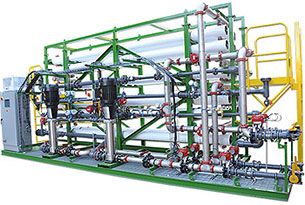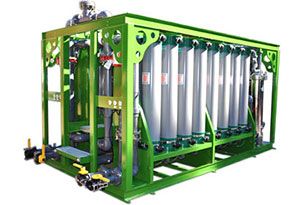Summary
Ultrafiltration (UF) and reverse osmosis (RO) are membrane-based technologies common to wastewater treatment and water purification. UF removes larger particles and pathogens through physical sieving, while RO achieves high-purity water by rejecting dissolved salts and small molecules. This article explains their mechanisms, differences, applications, and guidelines for specification in systems requiring contaminant removal.
Table of Contents
- Introduction
- Ultrafiltration: Process Overview and Technical Details
- Reverse Osmosis: Process Overview and Technical Details
- Key Differences: Comparison Table
- Applications and When to Specify UF or RO
- Challenges in UF and RO Systems
- Solutions to Common Challenges
- Conclusion
- Glossary of Terms
- FAQ
- Bibliography
Introduction
Membrane technologies play a critical role in wastewater treatment and water purification by separating contaminants based on size and solubility. These pressure-driven processes utilize semi-permeable membranes to produce clarified or purified water, with UF suited for pre-treatment or standalone clarification and RO enabling demineralization for high-purity applications. Understanding these processes is vital for specifying them in systems where water quality must meet stringent standards, such as in industrial reuse or potable production [1].
Ultrafiltration: Process Overview and Technical Details
Ultrafiltration is a membrane filtration process that uses hydrostatic pressure to force water through a semi-permeable membrane, retaining particles based on size exclusion. Membranes typically have pore sizes ranging from 0.01 to 0.1 micrometers (10 to 100 nanometers), allowing the removal of suspended solids, colloids, bacteria, viruses, and macromolecules while passing dissolved salts and small organics [2].
The process operates under low pressure, generally 1 to 10 bar (approximately 14.5 to 145 psi), which minimizes energy consumption compared to finer filtration methods. Water is pumped across the membrane surface, where larger contaminants are retained as retentate and periodically flushed away. Common configurations include dead-end filtration, where all feed water passes through the membrane, and cross-flow mode, which uses tangential flow to reduce fouling by sweeping away accumulated materials [3].
Technical performance can be modeled using Darcy's law for flux (J), the volume of permeate per unit area per time:
Where:
- is the permeate flux (m3/m2/s),
- is the transmembrane pressure (),
- is the dynamic viscosity of the feed (),
- is the total resistance (), including membrane and fouling layers.
This equation highlights how pressure drives separation, with resistance increasing due to fouling over time. Materials for UF membranes include polymeric types (e.g., polyvinylidene fluoride or polysulfone) and ceramic variants (e.g., alumina or zirconia), offering durability in harsh conditions [4].
UF excels in removing turbidity (often to <0.1 NTU), pathogens like E. coli and Cryptosporidium, and organic matter, but it does not significantly reduce total dissolved solids (TDS) [5].
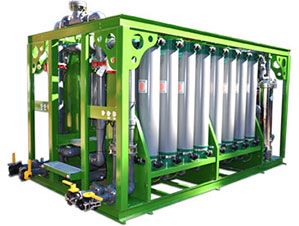
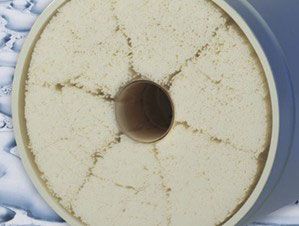
Reverse Osmosis: Process Overview and Technical Details
Reverse osmosis is a diffusion-based separation process that applies pressure to overcome natural osmotic pressure, forcing water through a dense, non-porous membrane while rejecting dissolved solutes. RO membranes have effective pore sizes less than 0.0001 micrometers (0.1 nanometers), enabling the removal of ions, salts, heavy metals, nitrates, and most organics [6].
The driving force is external pressure exceeding the osmotic pressure (π) of the feed solution, calculated as:
Where:
- is osmotic pressure (Pa),
- is the Van't Hoff factor (number of particles per solute molecule),
- is molar concentration (mol/L),
- is the gas constant (8.314 J/mol·K),
- is absolute temperature (K).
For example, in seawater with approximately 0.6 M NaCl (i ≈ 2), at 298 K, π ≈ 2.9 × 10^6 Pa (about 29 bar). Applied pressures for RO range from 10 to 100 bar (145 to 1450 psi), depending on feed salinity; brackish water requires lower pressures (15-25 bar) than seawater (50-80 bar) [7].
Osmotic pressure calculation: Start with solute concentration (M) from feed analysis, determine i based on dissociation (e.g., 2 for NaCl), use R = 8.314, and T in Kelvin. This yields π, guiding the minimum pressure needed; actual systems apply 1.2-1.5 times π for efficient flux.
RO produces permeate with TDS often below 10 mg/L and rejects over 99% of salts. Membranes are typically thin-film composites with a polyamide layer on a porous support, operating in cross-flow mode to minimize concentration polarization [8].
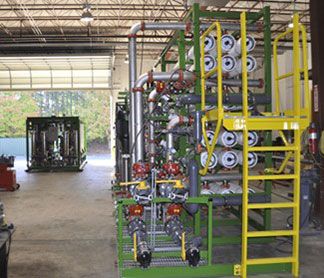
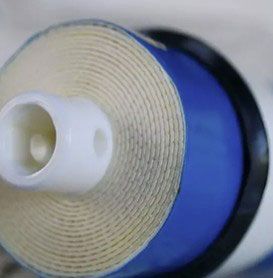
Key Differences: Comparison Table
| Feature | Ultrafiltration (UF) | Reverse Osmosis (RO) |
|---|---|---|
| Pore Size | 0.01 - 0.1 μm (10 - 100 nm) | < 0.0001 μm (0.1 nm) |
| Pressure | Low (1-10 bar; 14.5-145 psi) | High (10-100 bar; 145-1450 psi) |
| High Removal (>90% rejection) | Suspended solids (>10 nm), colloids (e.g., clay particles 10-100 nm), bacteria (0.2-10 µm, e.g., E. coli), viruses (>20 nm, e.g., norovirus), protozoa (1-100 µm, e.g., Cryptosporidium, Giardia), macromolecules (MWCO 1,000-500,000 Da, e.g., proteins, polysaccharides), larger organics (e.g., humic acids >10 nm), particulate heavy metals (e.g., lead colloids >10 nm). | Dissolved salts (e.g., NaCl >99%), ions (monovalent like Na+, Cl- ~95-99%; divalent like Ca2+, Mg2+ >99%), dissolved heavy metal ions (e.g., Pb2+ >95%, As3+ >95%), most organics (including small molecules <1 nm, e.g., pesticides, pharmaceuticals >95%), nitrates (NO3- >90%), sulfates (SO4^2- >99%), fluoride (F- >90%), PFAS (>95%), radioactive isotopes (e.g., uranium ions >95%); also suspended solids, colloids, bacteria, viruses, protozoa, macromolecules (>99%). |
| Fair Removal (50-90% or variable, depending on form, pH, membrane type) | Some smaller viruses (10-20 nm), some organic molecules (e.g., certain pesticides if aggregated), some heavy metals if bound to particulates or colloids (e.g., arsenic adsorbed to iron oxides). | Some small neutral molecules (e.g., certain volatile organics like chloroform ~80-95%), gases (e.g., CO2 partial passage), some boron species (~50-90% in standard RO, higher with specialized membranes). |
| Low Removal (<50% rejection) | Dissolved salts (e.g., NaCl), ions (monovalent like Na+, Cl-; divalent like Ca2+, Mg2+), dissolved heavy metal ions (e.g., Pb2+, As3+ in ionic form), small organics (e.g., volatile organics <1 nm), nitrates (NO3-), sulfates (SO4^2-), fluoride (F-), radioactive isotopes in dissolved form. | Dissolved gases (e.g., O2, N2), some uncharged very small organics (e.g., methanol if present, though rare in water; typically <10% rejection for such). |
| Energy Usage | Lower, due to reduced pressure requirements | Higher, to overcome osmotic pressure |
| Pre-treatment Needs | Primary, secondary, and mild tertiary | Primary, secondary, and strong tertiary |
| Water Recovery Rate | High (>90%) | Moderate (50-75%)* |
| Typical Flux | 50-200 L/m2/h | 10-50 L/m2/h |
This table illustrates how UF prioritizes particulate removal with efficiency, while RO focuses on solute rejection [9].
* The water recovery rate for reverse osmosis (RO) systems refers to the percentage of feed water that is converted into permeate (purified water), with the remainder becoming concentrate or brine waste. The 50-75% range listed in the comparison table is a generalization based on typical performance across a variety of common applications, particularly in scenarios with moderate to high total dissolved solids (TDS) levels, such as brackish water treatment or industrial wastewater where scaling and fouling risks limit higher recoveries to prevent membrane damage [4][8]. This range is conservative and aligns with many standard commercial and desalination systems, where pushing beyond it without optimizations can lead to increased energy use, frequent cleaning, or reduced membrane lifespan due to concentration polarization and osmotic pressure buildup [10].
However, RO recovery rates can indeed reach 80-90% or higher in optimized setups, especially for low-TDS feeds like certain municipal wastewater, brackish groundwater, or industrial process water with effective pre-treatment (e.g., ultrafiltration to remove particulates) and anti-scalant dosing [11][12][13]. For instance, advanced high-recovery RO configurations, such as multi-stage systems or those incorporating flow reversal or concentrate recycling, can achieve 85-95% recovery while minimizing waste [14][15].
In contrast, seawater RO is often capped at 35-50% due to extreme salinity, while brackish applications more commonly hit 70-85% [2][16]. The table's range reflects a "moderate" average for broad educational purposes, but real-world variability depends on factors like feed TDS, pH, temperature, and system design—higher recoveries are possible but not universal without trade-offs in cost or maintenance [17].
Applications and When to Specify UF or RO
Specification of UF or RO is appropriate when specific contaminant profiles necessitate their unique separation capabilities. UF is needed for wastewater treatment where removal of particulates and pathogens is critical, such as tertiary treatment in municipal plants or pre-treatment for finer processes; it is essential when high turbidity or microbial loads threaten downstream equipment or discharge compliance, but dissolved minerals can remain [1].
RO is required for demineralization in scenarios like desalination or ultrapure water production (e.g., pharmaceuticals, electronics), where elevated TDS, salts, or ions would cause scaling, corrosion, or product contamination; it is indispensable for brackish or seawater feeds exceeding 500 mg/L TDS or when near-zero TDS output is mandatory [2].
Both are needed in integrated systems for comprehensive treatment of complex feeds, such as industrial wastewater reuse, where UF protects RO from fouling while RO handles dissolved contaminants; this combination is appropriate for achieving high recovery rates and purity in challenging sources like pharmaceutical effluents [3]. When specifying we first analyze feed water quality (TDS, turbidity, pathogens via lab tests); if particulates and microbes dominate without high salinity, UF will do the job; if ionic removal is essential, RO is required.
Challenges in UF and RO Systems
Fouling remains a primary challenge: organic, inorganic scaling, biofouling, and colloidal deposition reduce flux and increase pressure needs. UF faces surface cake formation, while RO is susceptible to scaling from salts like calcium carbonate [9]. High energy demands in RO and membrane degradation from chlorine or pH extremes are also of high concern.
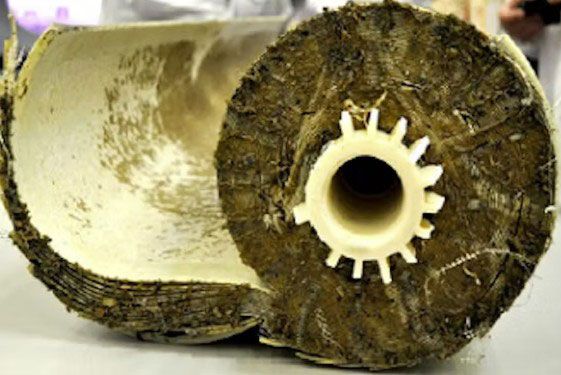
Solutions to Common Challenges
Pre-treatment with UF mitigates RO fouling by removing particulates. Cleaning methods include physical backwashing for UF and chemical agents (e.g., citric acid for scaling) for RO. Antiscalants and pH adjustment prevent precipitation. Emerging solutions like nanomaterial-modified membranes enhance antifouling properties [4].
Conclusion
UF and RO provide robust solutions for wastewater treatment and water purification, with UF offering efficient particulate removal and RO enabling demineralization. Specify them based on feed characteristics and effluent needs accordingly.
Glossary of Terms
- Antiscalant: Chemical additive used to prevent scaling on membranes by inhibiting precipitation of insoluble salts.
- Bar: Unit of pressure equal to 100 kilopascals, commonly used for membrane operating pressures.
- Brine: Highly concentrated salt solution rejected as waste in RO processes.
- Concentration Polarization: Accumulation of rejected solutes at the membrane surface, leading to reduced flux and increased osmotic pressure.
- Da: Dalton, a unit of molecular mass equivalent to one unified atomic mass unit (u).
- EPA: Environmental Protection Agency, a U.S. regulatory body setting water quality standards.
- Flux (J): Rate of permeate production per membrane area, often in liters per square meter per hour (L/m2/h).
- Fouling: Accumulation of contaminants on membranes, reducing performance.
- L/m2/h: Liters per square meter per hour, a unit for measuring membrane flux.
- MWCO: Molecular Weight Cut-Off, the lowest molecular weight (in Da) at which 90% of solutes are retained by the membrane.
- nm: Nanometer, a unit of length equal to 10^{-9} meters, used for pore sizes.
- NTU: Nephelometric Turbidity Units, a measure of water clarity.
- Osmotic Pressure (π): Pressure required to stop solvent flow across a membrane due to concentration differences.
- Pa: Pascal, the SI unit of pressure.
- Permeate: Filtered water passing through the membrane.
- PFAS: Per- and polyfluoroalkyl substances, persistent contaminants often targeted in advanced treatment.
- pH: Measure of acidity or alkalinity of a solution, on a scale from 0 to 14.
- psi: Pounds per square inch, a unit of pressure.
- Retentate: Concentrated reject stream containing retained contaminants.
- RO: Reverse Osmosis, a membrane process for removing dissolved solutes.
- Scaling: Deposition of insoluble mineral salts (e.g., calcium carbonate) on membrane surfaces, a form of fouling.
- TDS: Total Dissolved Solids, the concentration of inorganic and organic substances dissolved in water, measured in mg/L.
- Transmembrane Pressure (ΔP): Pressure difference across the membrane driving filtration.
- UF: Ultrafiltration, a membrane process for removing suspended particles and macromolecules.
- µm: Micrometer, a unit of length equal to 10^{-6} meters, used for pore sizes.
- ZLD: Zero Liquid Discharge, a treatment approach that eliminates all liquid effluent, often through integration of membranes with evaporation or crystallization.
FAQ
- What is the main difference in contaminant removal between UF and RO? UF removes larger particles and pathogens but not dissolved salts, while RO rejects nearly all dissolved and suspended contaminants.
- When should UF be specified as pre-treatment for RO? In feeds with stubborn persistent turbidity or organics to prevent RO fouling and extend membrane life.
- How does temperature affect RO performance? Higher temperatures reduce osmotic pressure (per π = iMRT) and viscosity, increasing flux, but may accelerate fouling.
- What maintenance is required for these systems? Regular backwashing for UF and chemical cleaning for RO, with monitoring of pressure and flux.
- Can UF and RO achieve zero liquid discharge? Not standalone, as both produce waste streams (retentate from UF and concentrate from RO), but they are key components in integrated ZLD systems; UF pre-treats to protect RO, which concentrates dissolved solids, with further steps like evaporation or crystallization eliminating all liquid discharge for full ZLD.
Bibliography
- [1] A Review on the Use of Membrane Technology Systems in Developing Countries - PMC
- [2] Ultrafiltration vs Reverse Osmosis - Seven Seas Water
- [3] Importance of Ultrafiltration as a pre-treatment before RO
- [4] A Review on Reverse Osmosis and Nanofiltration Membranes for Water Purification
- [5] A critical review of point-of-use drinking water treatment in the United States
- [6] Strategy towards the use of ultrafiltration and reverse osmosis for industrial water recovery and reuse as part of the Green Deal Implementation
- [7] Osmosis Equation - Chemteam
- [8] Water Reuse: The Potential for Ultrafiltration and Reverse Osmosis
- [9] A comprehensive review of RO membrane fouling: Mechanisms, categories, cleaning methods and pretreatment technologies
- [10] Reverse Osmosis Recovery Rate
- [11] Reverse Osmosis Optimization - Energy.gov
- [12] Reverse Osmosis - The Basics
- [13] POU Reverse Osmosis Performance and Sizing
- [14] High Recovery Reverse Osmosis
- [15] Industrial Water Treatment, Reverse Osmosis Systems & Configurations
- [16] The Difference Between Reverse Osmosis and High Recovery Reverse Osmosis - Waterleau
- [17] Water recovery from reverse osmosis concentrate by commercial nanofiltration membranes: A comparative study
Have a project you would like to discuss?
Contact Ecologix Environmental Systems today to learn more about our engineered solutions.
Contact Us